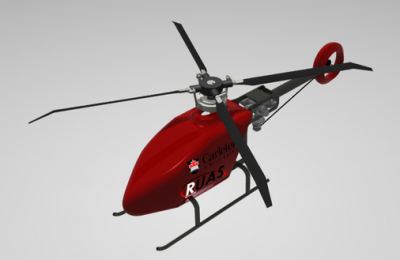Unique research
The Department of Mechanical and Aerospace Engineering at Carleton has been conducting rotorcraft research for more than 15 years and encompasses faculty from three different departments. Carleton’s Rotorcraft Research Group was established in 2003 and has seen more than 30 PH.D. and Masters students graduate from the group.
Unique research

Areas of expertise include rotor aerodynamics and aeroelasticity, blade dynamics, rotor-based vibration and noise control, blade design and manufacturing, active control systems, and energy harvesting. Rotorcraft researchers also collaborate with the Department of Psychology, through the Advanced Cognitive Engineering Laboratory (ACE Lab) to combine rotorcraft with flight simulation and human factors research in the study of human-machine interaction. State-of-the-art studies of helicopter-ship-wake interaction have also been conducted computationally, in wind tunnel experiments, and through field research.
A notable achievement is in the area of computational fluid dynamics. A full aeroelastic/aeroacoustic code based on the Discrete Vortex Method has been developed for modelling full helicopter configurations. The code has been used for a world-first simulation of active stiffness control of helicopter rotors, as well as first-in-Canada simulations of full helicopter flow fields.
Rotor research at Carleton has also seen the development of two innovations: SHARCS (Smart Hybrid Active Rotor Control System) and the patented Smart Spring. The objective of the SHARCS initiative is to develop a blade that reduces noise from vibration in helicopters. The Smart Spring is placed in the hub of the rotor, reducing vibration. These technologies are being used to reduce noise and vibration in helicopters and to improve the efficiency of deep-sea wind turbines.
The Rotorcraft Research Group is also active in the research and development of Unmanned Aerial Vehicle (UAV) rotorcraft. This includes examining efficient airframe design and the development of autopilots for an array of flight environments. Design of Micro Aerial Vehicles (MAVs) is being pursued in collaboration with the Department of Biology, pulling aerodynamic and structural observations from nature.
Facilities include a wind tunnel for investigating two-dimensional vortex-rotor blade interactions. A dedicated wind tunnel with a sophisticated particle-imaging velocimetry (PIV) system for flow measurements used to study the flight of insects such as dragon flies. And two whirl tower facilities, which allow for measurement of rotor blade flows and are used to examine active stiffness-control technology and helicopter-ship-wake interaction.





